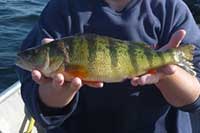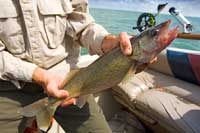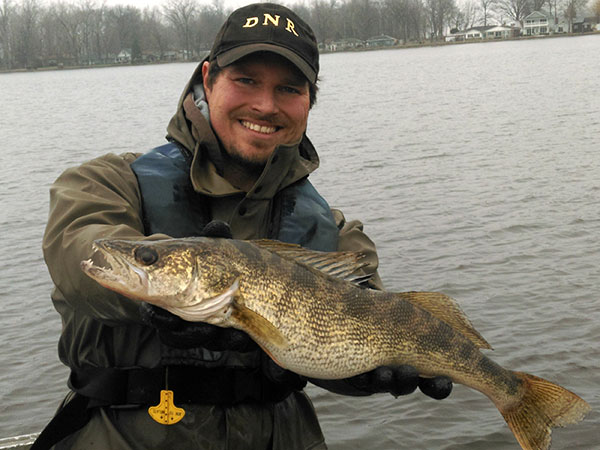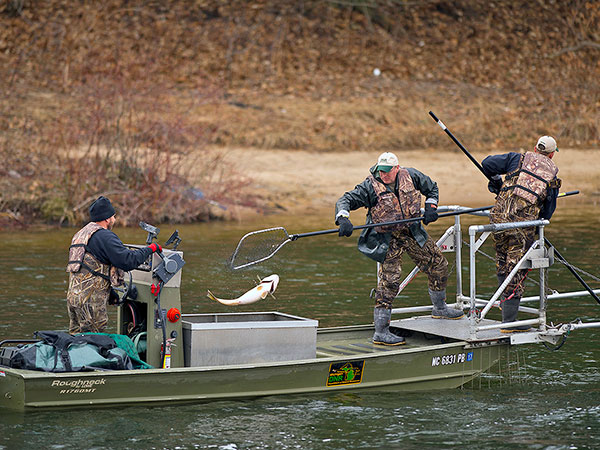- Details
(Provided by Michigan DNR)
 Yellow PerchThe Michigan DNR approved changes to walleye and yellow perch recreational fishing regulations in Saginaw Bay. The new regulations went into effect immediately.
Yellow PerchThe Michigan DNR approved changes to walleye and yellow perch recreational fishing regulations in Saginaw Bay. The new regulations went into effect immediately.
For walleye, the daily possession limit is increased from five (5) to eight (8) fish and the minimum size limit is reduced from 15 to 13 inches. For yellow perch, the daily possession limit is reduced from 50 to 25 fish.
Walleye have recovered and are very abundant in Saginaw Bay, and while this recovery is considered a success story, walleye are now suppressing the available prey base. Some of the consequences of less available prey are slower walleye growth and poor survival of juvenile yellow perch. Yellow perch are reproducing very well (like walleye), but young perch are not surviving, which may be in part due to walleye predation. As a result, the adult yellow perch population has been greatly reduced.
The waters of Lake Huron where these regulation changes for walleye and yellow perch will change are known as Lake Huron management unit MH-4 (www.michigan.gov) includingthe Saginaw River up to the Center Road Bridge in Saginaw. Fishing seasons for walleye and yellow perch were not changed for these waters.
- Details
(Provided by Michigan DNR)
 Partners help Michigan stock more than 4 million walleyeThe Michigan DNR announced the totals from its annual walleye rearing pond harvest and stocking of walleye fingerlings. The DNR's Fisheries Division and tribal partners stocked nearly 4.7 million walleye fingerlings in more than 110 water bodies located throughout Michigan this spring and summer.
Partners help Michigan stock more than 4 million walleyeThe Michigan DNR announced the totals from its annual walleye rearing pond harvest and stocking of walleye fingerlings. The DNR's Fisheries Division and tribal partners stocked nearly 4.7 million walleye fingerlings in more than 110 water bodies located throughout Michigan this spring and summer.
Walleye ponds are a critical component of the DNR's coolwater fisheries management and have been used extensively since the mid-1970s. More than 30 walleye ponds located throughout Michigan were used this year, and most rely heavily on the support of local sportsmen's organizations.
These groups assist with the ponds' finances and supply volunteers to help with fertilization, pond maintenance and fish harvest.
- Details
By Louie Stout
 Indiana biologist Jamie Pejza shows off a Lake of Woods walleye netted during survey.The St. Joseph River isnt the only burgeoning walleye fishery on South Bends doorstep.
Indiana biologist Jamie Pejza shows off a Lake of Woods walleye netted during survey.The St. Joseph River isnt the only burgeoning walleye fishery on South Bends doorstep.
Indiana biologists say a pretty good one continues to show promise at Lake of the Woods in Bremen.
Biologist Tom Bacula spent a few days last month sampling the lakes walleye population with a netting project and came away pretty satisfied.
I am pretty happy with the catch of 15- to 18-inch walleyes we saw, said Bacula. They looked very healthy and had great color. We didnt get any of the giants Ive heard anglers talk about, but some nice keeper fish.
The DNR gang set fine mesh traps on sand bars in water 5 to 7 feet deep then checked them daily.
- Details
(Provided by Michigan DNR)
 Biologists working shock boat capture walleyes for egg taking purposes.As many anglers know, much of Michigans inland-waters walleye fishery is supported by hatchery-raised fish. What many dont know is that the source of those fish - the Muskegon River, below Croton Dam - is supported by hatchery-raised fish, too.
Biologists working shock boat capture walleyes for egg taking purposes.As many anglers know, much of Michigans inland-waters walleye fishery is supported by hatchery-raised fish. What many dont know is that the source of those fish - the Muskegon River, below Croton Dam - is supported by hatchery-raised fish, too.
"Theres not a lot of natural reproduction in the system, said Rich ONeal, the Department of Natural Resources fisheries biologist who oversees the Muskegon River watershed. Were getting very low production in the river. Were not sure why, but we think water velocity or water temperature could have something to do with it. We know we get good natural reproduction further upstream.
There are 3 to 4 billion eggs laid here when theyre spawning, but were just not getting fry production.
It took a stocking effort to rebuild the Muskegon River population after it collapsed in the 1960s. ONeal said sea lamprey predation - the preying of one animal on another - on adult walleyes was part of the problem, but alewife predation on juveniles also was a factor. We saw that all over the Great Lakes, he said.





